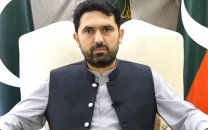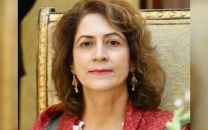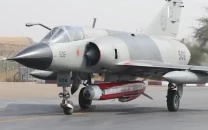Fair game: Female footballers
Kicking ball is not child's play for women in Pakistan.

Kicking ball is not child,s play for women in Pakistan. PHOTOS BY NADIR TOOSY
Today is the last day of the Sindh regionals and only two of the best teams will qualify to play the quarter-finals for the 2013 Women’s National Championship. And like every other girl, Zulfi aches to be on the winning side. For a sport that hardly gets its share of resources, importance or glory in the country, this was a big moment. Even though Zulfi has been playing as a left-winger for her team, Balochistan United for over three years now, this match is an important one. The competition is tough but they are prepared. After all, they have been training every day for almost six months now, even through Ramazan.
“I came here once when I was younger, about 11 or 12,” she says pointing towards the football ground at the Aga Khan Gymkhana, Karachi, “and as soon as I saw girls playing here, I knew I wanted to join them.” But her family was not thrilled with the idea. “My father stood up for me, he said I should do it,” she went on. “The rest of my family doesn’t want talk to me anymore. What is it to me? I don’t care. I am not going to stop playing football.”
Zulfi’s story is not an isolated one. In fact, it is rather mild compared to the other ones. For most women in Pakistan, wanting to kick a ball comes with a huge set of challenges. And yet, many of them continue to do so, despite all odds.

Women’s football first sprang its roots officially in 2004 although it is for sure that there were women in Pakistan who had kicked a ball before that. “Bringing women’s football to Pakistan was no easy feat,” says Rubina Irfan, a senator, chairperson of the women’s wing of the Pakistan Football Federation (PFF) and the owner of the Balochistan United Women’s Football Club (WFC). Known as one of the pioneers of the sport in Pakistan, Rubina has invested a considerable time, effort and money in the sport. “When I saw my girls [who were] barely six and seven play football with their male cousins, I knew right then that I wanted them to play later in their lives,” she says. “Who am I stop them?”

Starting a women’s football team was challenging for Rubina, but not entirely unachievable as she belongs to a family of football enthusiasts. Her father, husband and brothers not only played the sport but was also responsible for setting up one of the first teams in Balochistan. She contacted Akhtar Moinuddin, a former Pakistan men’s national coach who worked at the PFF and was extremely supportive of the idea. Next, she got in touch with Mohsin Gillani, the South Asian representative for FIFA who assured her that there was a future for girls in football. Rubina went on to present the idea for bringing women’s football to Pakistan to over 200 countries at a FIFA conference in Shanghai in 2004. The effort was not in vain as FIFA pledged 10 percent of its funds to be allocated to women’s football in Pakistan.

Nine years on, there are 43 WFCs registered in Pakistan, although actual figures are believed to be much higher since many of them are not registered with the PFF due to technical rules or a lack of players.
“There can be as many as 100,000 women in Karachi who could have the potential to play football,” Rubina says, “but we don’t know about them.” During the initial stages of setting up her team, Rubina would go knocking on the doors of each player’s house to talk to their families. She discovered that every family had the same demand — that their girls be treated with respect, something that sport players are often denied in Pakistan. Once she promised the families that, girls from even conservative areas like Sibi, Kalat, Kohlu, Quetta, Awaaran, Mashkey,Vihari, Qilla Saifullah and Hunza began to play.
Today, girls from all backgrounds including Baloch, Ismailis, Hazara Shias, Christians and those from Karachi play together on Rubina’s team, regardless of their religious and social identities. “For women to progress in Pakistan, we do not need to draw even more lines between them,” she says.

Many girls, such as Shahida Raza, known as Chintoo, transitioned to football from other more commonly played sports such as hockey and cricket, Women on the national team have an advantage and can play even in their late 20s and 30s, unlike the men’s teams in which the average age is much lower. For Chintoo, who plays for the Balochistan United WFC and has participated in eight women’s national championships, playing is not just a passion but also a source of livelihood. The winning money which can range anywhere from the Rs5,000 individual bonuses for outstanding performances up to Rs30,000 prize money for bigger tournaments, contributes to her family income. The amount varies according to the proportion the club decides to retain for reinvestment in training.
Playing in urban centers like Karachi is relatively easier. “I remember in autumn of 2010, one of my friends told me [that] Karachi United was holding women’s trials,” says 20-year-old Nina Zehri, a student from Karachi. “But they weren’t really proper trials,” she says. “I think at that time no one really knew how to play, it was more for encouraging us to learn.”

However, according to Adeel Rizki, head coach at Karachi United, things seem to have improved a lot over the past three years. While the number of tournaments held for girls were still far fewer in comparison to those for men, parents’ attitudes towards the sport seemed to be shifting. “Lots of parents had spoken to me about getting their girls to play as well. They sent their sons and wanted similar opportunities for their daughters,” he explains, referring to the motivation to start training camps for girls of all ages, from toddlers to the women’s team.
It was because of her mother’s encouragement that 16-year-old Joyanne Geraldine started playing football. “We started playing in our church ground where there were about 25 girls,” she recalls, “but as we grew older, many lost interest.” Joyanne says that Ahmed Jan, the owner of the KMC football stadium located in Saddar, Karachi, pushed her to keep playing. Jan has been particularly commended for making it easier for women football clubs to train and play matches by lending the ground to them free of charge.
Renting a ground to play or practice is expensive business. A ground located in Boat Basin, Karachi, may be three-fourth the size of an original field but can cost up to Rs6,000 for a mere two hours. This adds up the six-day rental cost to approximately Rs144,000 a month, all for just two hours of play. While some club managers like Rubina use their personal savings to fund training, others rely on member contributions to cover these expenses. According to Rubina, it is the only way to sustain the sport since the government only allocates Rs1.5 million per year to both men and women’s football, which is not enough.
The financial constraints are not just limited to practices. While corporate sponsors readily back men’s tournaments due to higher turnout and better brand visibility, there is barely any enthusiasm for the female version. To counter these attitudes, a 10-minute exhibition match for women’s football was held during a men’s tournament recently. The idea was to show the sponsors that women could play football too.
Apart from a lack of finances, corruption is another major problem. In a letter of complaint submitted to the PFF, a spectator at one of the regional matches held in Karachi last month, complained of a false goal credited to a club and the referee’s callous attitude towards the mistake. The letter also mentions the poor state of the ground and playing conditions that day.
“It just shows [that] they don’t take us seriously,” says Zoya Hasan, a 23-year-old law student and football player. “Regionals like this are supposed to be a big deal, and should be considered that way.”
The PFF website also shows the original scheduled date for the women’s national championship as September, but which has now been delayed to November. Many other scheduled tournaments did not take place either, raising serious questions about the auditing, reporting and accountability of the PFF. If the sport is to flourish, there is a dire need for transparency.
Despite all their shortcomings, the regional tournaments were proof of one thing — that there are women in Pakistan who not only want to play football but also be good at it. Sixteen teams competed for the top eight spots in the National Women’s Championship to be held sometime in December this year. At the nationals, the battle will be for the championship title. But as the regional results show, matches can be extremely favourable to one team, with as many as 15 or 17 goals for one side while the other side fails to score even one. This shows the stark disparity in coaching standards among different teams. “For the girls to perform to their optimum, it is essential for them to be comfortable with their coaches and managers. That can only happen if they [coaches and managers] are hired on merit and not changed sporadically to grant favours,” Rubina emphasizes.
In the same tournament, the FATA team also pulled out of their group at the last minute due to security concerns from families. With a much smaller pool of teams competing for the national tournament now, the competition will be much tougher. Many of the girls hope to showcase their talent and get picked up by scouts for the national women’s team. Nina admits that her ultimate goal in football is to represent Pakistan. Shahlyla Irfan, who started playing at the age of six, says, “If there is a future in football, I want to play all my life.” But the passion and talent needs to be channeled correctly in order to make that future a bright one. According to the official FIFA website, the Pakistan women’s national football team currently ranks at 109 (out of a total of 120 teams) with sides such as Bangladesh, India, Malaysia and Philippines ranking much higher.
During the interview, Rubina’s phone rings. A TV channel is calling, and she talks for a minute about the folk singer, Reshma, who recently passed away. “You see, this is what they do,” she says, sounding distressed. “We have artists and ambassadors of Pakistan and we let them die in poverty and disease. They deserve to be treated with respect. They give so much to Pakistan that we don’t appreciate till it’s too late.” She emphasises that the situation is quite similar for women football players of Pakistan who need to be idolized as they are role models for the next generation. While they continue to struggle for the basics in Pakistan, female footballers in other South Asian countries such as Nepal and India are miles ahead. Not only do these countries provide incentives for women to start playing football professionally but they are also allotted government jobs in Nepal and are guaranteed employment, housing and utility payments for all the players on the national team in India.
“How can we expect our women to concentrate on football if their heads are full of worries about where their next meal is going to come from? This is not how stars are born!” says Rubina. She insists that these girls deserve scholarships so that their education does not suffer due to the sport.
In the meanwhile, these young passionate footballers continue playing in the hope that they will one day be discovered and celebrated for their talent. To keep the fire burning, they narrate examples of other female footballers across the globe who have not given up on the sport, despite all obstacles. They take solace in stories like that of Brazilian player Marta Vieira da Silva, who does not have a club or contract to her name despite being named player of the year five consecutive times by FIFA — a glaring proof that football is still considered a man’s territory. Even though their own realities are far more severe, there is a strange consolation in knowing that they are not alone in their struggle.
“Who wouldn’t work their butt off for all that glory?” asks Joyanne wistfully. One glance at the girls on the field with their sweaty limbs and steady resolve would tell you that there are many who agree with her.
Myra Khan works in the education sector and also loves to write on the side. She tweets @myrakhan
Published in The Express Tribune, Sunday Magazine, November 24th, 2013.



















COMMENTS
Comments are moderated and generally will be posted if they are on-topic and not abusive.
For more information, please see our Comments FAQ